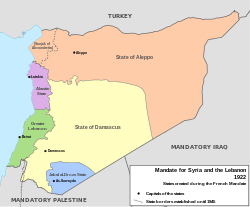State of Greater Lebanon (1920–1926) État du Grand Liban دولة لبنان الكبير Lebanese Republic (1926–1943) République Libanaise الجمهورية اللبنانية | |||||||||
|---|---|---|---|---|---|---|---|---|---|
| 1920–1943 | |||||||||
 Location of Greater Lebanon (green) within the Mandate for Syria and the Lebanon | |||||||||
| Status | Mandate of France | ||||||||
| Capital | Beirut | ||||||||
| Common languages | Arabic French English Armenian | ||||||||
| Religion | Christianity Islam | ||||||||
| High Commissioner | |||||||||
• 1920–1923 (first) | Henri Gouraud | ||||||||
• 1944–1946 (last) | Étienne Paul Beynet | ||||||||
| President | |||||||||
• 1926–1934 (first) | Charles Debbas | ||||||||
• 1943 (last) | Émile Eddé | ||||||||
| Prime Minister | |||||||||
• 1926–1927 (first) | Auguste Adib Pacha | ||||||||
• 1943 (last) | Riad Al Solh | ||||||||
| Historical era | Interwar period | ||||||||
• State created | 1 September 1920 | ||||||||
| 23 May 1926 | |||||||||
| 22 November 1943 | |||||||||
• Withdrawal of French forces | 17 April 1946 | ||||||||
| Currency | Syrian pound (1920–1939) Lebanese pound (1939–1946) | ||||||||
| |||||||||
The State of Greater Lebanon (Arabic: دولة لبنان الكبير, romanized: Dawlat Lubnān al-Kabīr; French: État du Grand Liban), informally known as French Lebanon, was a state declared on 1 September 1920, which became the Lebanese Republic (Arabic: الجمهورية اللبنانية, romanized: al-Jumhūrīyah al-Lubnānīyah; French: République libanaise) in May 1926, and is the predecessor of modern Lebanon.
The state was declared on 1 September 1920, following Decree 318 of 31 August 1920,[1] as a League of Nations Mandate under the proposed terms of the Mandate for Syria and the Lebanon which was to be ratified in 1923. When the Ottoman Empire was formally split up by the Treaty of Sèvres in 1920, it was decided that four of its territories in the Middle East should be League of Nations mandates temporarily governed by the United Kingdom and France on behalf of the League. The British were given Palestine and Iraq, while the French were given a mandate over Syria and Lebanon.
General Gouraud proclaimed the establishment of the state with its present boundaries after support from the majority of Lebanese regardless of religion and with Beirut as its capital.[2] The new territory was granted a flag, merging the French flag with the Lebanese cedar.
- ^ Emmanuel Brunet-Jailly (28 July 2015). Border Disputes: A Global Encyclopedia [3 volumes]: A Global Encyclopedia. ABC-CLIO. pp. 353–. ISBN 978-1-61069-024-9.
- ^ "Archived copy". Archived from the original on 24 February 2021. Retrieved 24 July 2008.
{{cite web}}: CS1 maint: archived copy as title (link)

